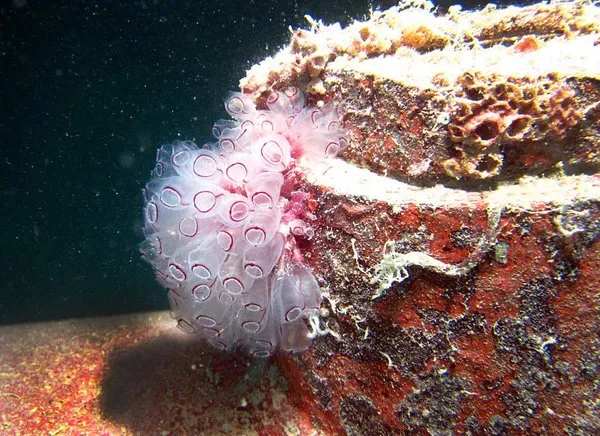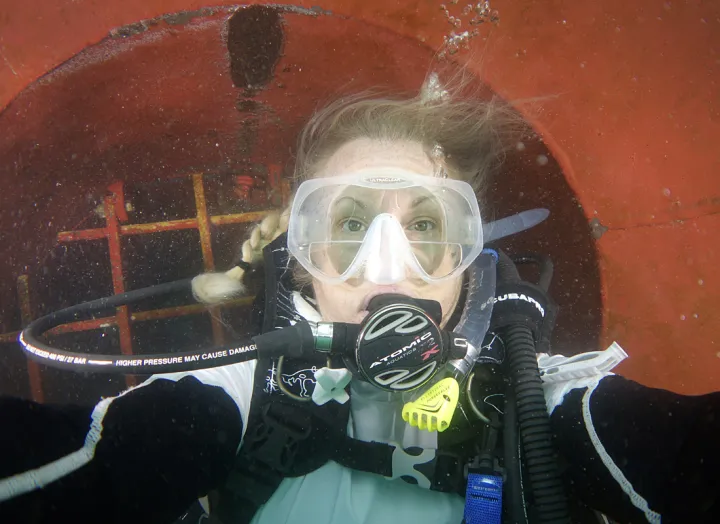Unearthing Information About Invasives From the Bottom of a Cargo Ship

I am once again leaving my familiar world behind and descending into the abyss below. The first dive of an entirely new expedition is the most magical. I am a member of a scientific research dive team studying biological invasions in coastal marine ecosystems off the coast of Bermuda for the Smithsonian Marine Invasions Research Lab. As I sink beneath the belly of a massive cargo ship, I glide my hand down the side of the vessel. The painted metal feels like smooth skin, but it is covered in a thin layer of brown biofilm, microbial life that clings to painted surfaces and is generally found covering the bottom of ships. Larger organisms reside inside the recesses of the ship’s hull.
Invasive species are fundamentally changing the structure and function of ecosystems around the world and impacting many dimensions of human society. Our research is important because the unintentional transfer of organisms by ships is the leading cause of biological invasions to coastal marine systems in North America, and also globally. ‘Biofouling’ organisms “hitch a ride,” attaching themselves to the hull and underwater surfaces of ocean-going vessels. Some of these species are the root cause of severe ecological, economic and human-health effects. The species—including the microbial biofilms—are also a major nuisance to shippers because they slow down the ships and increase fuel costs.
As I descend from the water surface at the bow of the ship, a large grated hole opens up in front of me and reveals its enormous propellers. I swim closer to the grate to get a better view inside the tunnel containing the bow thrusters. Before even entering the water, the dive team made sure to check with the ship’s captain and chief engineer that all moving parts—potential hazards, such as bow thrusters, propellers, rudders and stabilizers—are locked down and secured. Swimming up to a propeller twice your size is a wonderful moment, but only if you know it will not whisk you away or chop you into bits.
Occasionally during the dive I hear and feel the vibration of the ship “breathing.” The sound comes from the water intake vents, known as “sea chests,” which feed the ship’s cooling system and must remain operational. We are careful to avoid these areas of the hull. Low visibility—dimmed by the density of the particulates suspended in the water column—adds to the mystery, but I can make out the vague shapes of the other divers, ecologist Ian Davidson and researchers Lina Ceballos and Kim Holzer.
Ian photographs areas of interest and Lina is collecting specimens. In my excitement, I take a moment to grab a quick selfie.
Soon, I am catching the specimens Lina collects and sealing them in a plastic sample bag, and dropping them into the larger mesh bag I have clipped to my gear. I then record the location and sample bag number on a slate with a pencil, which are tethered to my body.
Simple tasks. Except everything wants to float or sink away, nothing wants to stay where I put it, including myself. If I spend too much time looking for something clipped to me, or writing on the slate, I look up to find I have drifted away from my intended position. Our pencils and slates float away like they are on their own mini spacewalk. If we don’t make sure that our tools are clipped to us, they are gone. We lost a slate once filled with data—it’s still down there somewhere. Fortunately, we had a duplicate available, otherwise we would have completely wiped-out an entire day’s work.
For the day’s second dive, we descend at mid-ship to go entirely underneath the ship’s belly. With every exhale, the bubbles collect above our heads onto the ship’s hull and reflect back at us like mirrors of mercury. Ian is trying to take pictures; too many bubbles are getting in his way. I move further away so with each exhale, I’m not contributing to his bubble problems. As I look back, I see a solitary scientist who appears completely engrossed in his work.
The third and fourth dives of the day are at the stern. Fatigue is starting to creep in, as we descend down the huge rudder. Visibility is poor and I almost swim right into the ship’s giant propeller. We proceed with the same sampling process, which by now feels like a routine.
On our fourth dive, our task is to take high-resolution images in small sections to create one deep-zoom image of the entire rudder. This is the last dive of the day and the most tedious, but I shoot 312 photographs just to create one image. Throughout the effort, I am constantly trying to maintain position, working slowly from left to right, from bottom to top, up the rudder, picture by picture.
After we return to the marine station by boat, we unload and wash down all the equipment, refill the boat with fuel, and haul our equipment back to the house to hang it out to dry. Next, we get to work. These vessel surveys are designed to evaluate the extent, composition and condition (live versus dead, reproductive condition, stuff like that) of the organisms.
Lina, Kim and Ian labor late into the night processing the specimens, while I download and manage today’s images. We’ll repeat this tomorrow and every day while we are here, weather permitting. Field time is expensive and precious. Bad weather can take that time away quickly, so we work constantly while we can.
When I return from the field, I am often asked by my family and friends what I experienced. Rarely do I have time to do what a tourist might, so I tend to miss a lot. However, any postcard that I send from Bermuda is going to say this: Today, what I experienced underneath the belly of a ship, was amazingly beautiful.
Editor's Note: This post originally appeared on Smithsonian.com.




